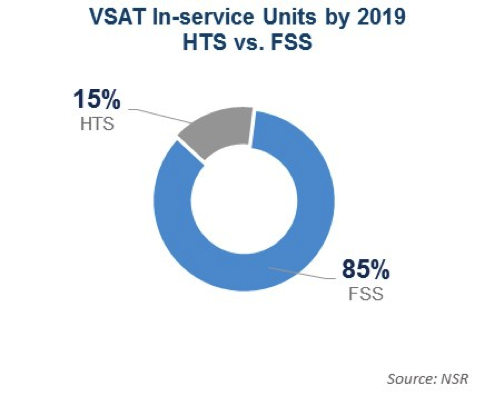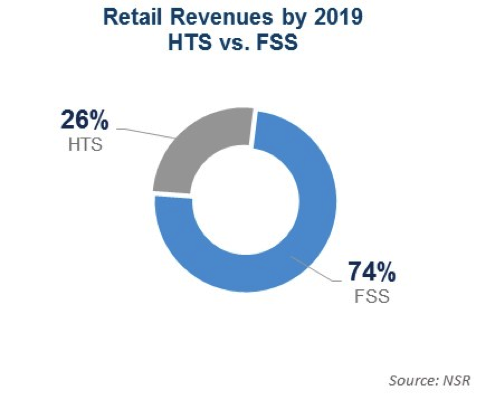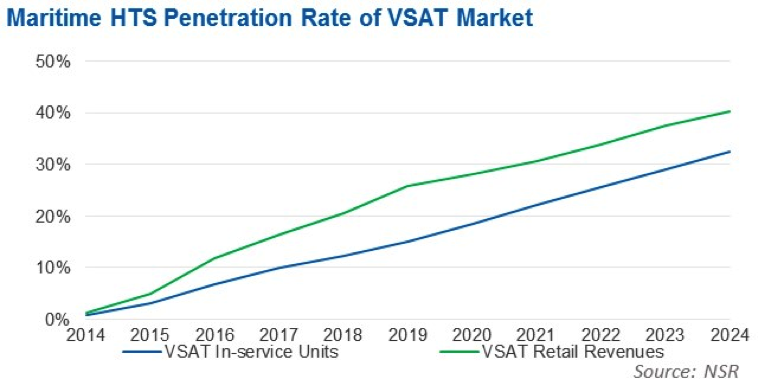Flexibility: A New Paradigm in Maritime Satcom
Jun 3rd, 2015 by
Brad Grady NSR
Growth in onboard applications has added another layer of
complexity to the maritime market, keeping maritime fleet IT
departments busier than ever. To make their life easier, the
satellite industry has integrated flexibility in network services
and operations, but is it enough to answer the growth in bandwidth
demand?
Within the satcom industry, service providers, satellite
operators, and hardware manufacturers are all undergoing a shift in
how satellite communications networks are designed, and deployed.
At the forefront of that change, and most visible to end-users, is
not only the migration from MSS to VSAT, but the introduction of HTS
services.
According to NSR’s Maritime Satcom Markets, 3rd
Edition over the next five years, over 4,000 HTS terminals will
enter the market, generating almost $450 million in VSAT retail
revenues for service providers. Compared against FSS markets,
in 2019 HTS will account for 15% of VSAT In-service Units, and 26%
of VSAT retail revenues.


That difference between In-service units and retail revenues in
the VSAT market is not because ‘new technology is more expensive’,
but that in the first five years, there will be higher-end customers
migrating towards HTS offerings and consuming larger amounts of
bandwidth, such as Royal Caribbean and O3b. However, with new
capacity coming online over the next five years and new technologies
changing the hardware landscape, the following five years are poised
for heavy growth in HTS-based offerings, but with a closer balance
between HTS In-service Unit market share and HTS Retail Revenues.
As end-users focus more on deriving value from the applications
and the ‘connected ship’, everything is on the table. From route
optimization in merchant shipping to improving seismic data handling
in the offshore sector to connecting the next wave of social media
apps in the cruise industry, the focus has turned towards
the applications. It will be these applications and
services that help push FSS (and HTS by association) into new
markets and vessel profiles.

Yet, the promise of HTS and the ‘connected ship’ has brought
challenges into the Maritime VSAT markets. Service providers
need capacity where their customers are, which becomes an extremely
complex equation with spot-beam-based HTS capacity. The answer
traditionally has been a closer relationship of the satellite
operator into the day-to-day management of end-user bandwidth.
We have already seen those ecosystems develop in the
consumer-broadband markets with ViaSat, Eutelsat, Hughes, etc.
Inmarsat with GX is another example for the mobility markets.
And, maybe even Intelsat is moving towards that model in their own
way with the recent announcement of their IntelsatOne Flex service.
Although still remaining an offering for service providers to
avoid some of the negative cost economics on their end (fewer hub
equipment required, etc.), one has to ask the question: What if
multiple high-end vessels are under the same spot-beam, but served
by different service providers? How much traditional FSS wide
beam capacity will need to be dedicated by Intelsat to allow service
providers to meet their SLAs with their customers (and who needs to
own it)? And, whose responsibility will it be to ensure any
transition happens seamlessly to the end-user? In other words,
is Intelsat’s new offering the closest approximation to a
scalable ‘infrastructure-as-a-service’ that service
providers can expect in the mobility space? With the
elasticity coming from FSS capacity, can we expect other satellite
operators with hybrid FSS and HTS satellites to follow?
Are other satellite operators likely to announce similar services
for mobility markets? The answer leans heavily towards “yes”.
However, that also does not mean the ‘traditional role’ of
service providers will be extinct. There are myriad
possibilities of how to operate in a hybrid environment, where just
as we’ve seen in traditional ‘cloud environments’, the right mix is
a little of owned infrastructure in high density areas, and access
to flexibility to buffer demand/supply. The real
question is if Intelsat has created a de-facto ‘closed ecosystem’
within its fleet, or if service providers and ‘Flex-enabled
vessels’ will still have a choice of satellite operator using the
same equipment.
Bottom Line
Intelsat’s recent announcement of their “Flex” service reminds us
of one thing – innovation behind the scenes is just as
important as innovations the customer can see and feel.
These days, maritime end-users do not need/want to be
bothered with the nuts-and-bolts of satellite communications – with
the onslaught of onboard sensors, remote monitoring, crew welfare
concerns, and health/safety regulations - the applications
themselves are occupying the time of end-user’s IT departments.
But, the jury might be out as to if this and the other likely
hybrid-infrastructure models have solved more questions than
answers. If nothing else it has helped simplify the
conversation between service providers and end-users which is the
ultimate goal, right?